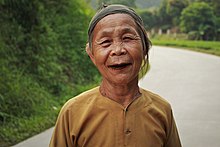.mw-parser-output .hidden-begin{box-sizing:border-box;width:100%;padding:5px;border:none;font-size:95%}.mw-parser-output .hidden-title{font-weight:bold;line-height:1.6;text-align:left}.mw-parser-output .hidden-content{text-align:left}@media all and (max-width:500px){.mw-parser-output .hidden-begin{width:auto!important;clear:none!important;float:none!important))You can help expand this article with text translated from the corresponding article in Vietnamese. Click [show] for important translation instructions.
Machine translation, like DeepL or Google Translate, is a useful starting point for translations, but translators must revise errors as necessary and confirm that the translation is accurate, rather than simply copy-pasting machine-translated text into the English Wikipedia.
Do not translate text that appears unreliable or low-quality. If possible, verify the text with references provided in the foreign-language article.
You must provide copyright attribution in the edit summary accompanying your translation by providing an interlanguage link to the source of your translation. A model attribution edit summary is Content in this edit is translated from the existing Vietnamese Wikipedia article at [[:vi:Người Sán Chay]]; see its history for attribution.
You may also add the template ((Translated|vi|Người Sán Chay)) to the talk page.
For more guidance, see Wikipedia:Translation.
Người Sán Chay | |
|---|---|
 | |
| Total population | |
| 252.000[1] (2019) | |
| Regions with significant populations | |
(Northern Vietnam, Central Highlands and Tuyên Quang) | |
| Languages | |
| Cao Lan, Pinghua Chinese, Vietnamese | |
| Religion | |
| Buddhism | |
| Related ethnic groups | |
| Zhuang, Buyei |
The San Chay people (Vietnamese: Người Sán Chay; also called Sán Chỉ) live in Tuyên Quang Province of the Northeast region of Vietnam, as well as some nearby provinces. The Pinghua language is a form of Chinese language.[3] Their population was 201,398 in 2019.
Many live in remote areas, using slash-and-burn agriculture because those areas are not flat enough for paddy rice production.[4]
They sing sình cồ (love songs) and celebrate the Slếch thlin mảy festival (New Rice festival).
The San Chay people are related with the Shanzi People in Guangxi, China.[5]
References
[edit]- ^ "Report on Results of the 2019 Census". General Statistics Office of Vietnam. Retrieved 1 May 2020.
- ^ Kết quả toàn bộ Tổng điều tra dân số 2019. p. 44. Trung tâm Tư liệu và Dịch vụ Thống kê, Tổng cục Thống kê, 19/12/2019. Truy cập 1/09/2020.
- ^ Jean Michaud (19 April 2006). Historical Dictionary of the Peoples of the Southeast Asian Massif. Scarecrow Press. pp. 257–. ISBN 978-0-8108-6503-7.
- ^ Jean-Christophe Castella (2002). Doi Moi in the Mountains: Land Use Changes and Farmers' Livelihood Strategies in Bac Kan Province, Viet Nam. Int. Rice Res. Inst. pp. 11–. ISBN 978-971-22-0270-4.
- ^ He Siyuan (1 Jan 2019). "广西十万大山山子话音系及核心词分析 / An Analysis on Phonology and Core Words of Shanzi Dialect of Shiwan Dashan of Guangxi". 百色学院学报 / Journal of Baise University. 32.
External links
[edit]| Austroasiatic (Vietic) | |
|---|---|
| Austroasiatic (non-Vietic) | |
| Hmong–Dao | |
| Tai–Kadai | |
| Sino-Tibetan languages | |
| Malayo-Polynesian | |
| Expatriate | |
| |